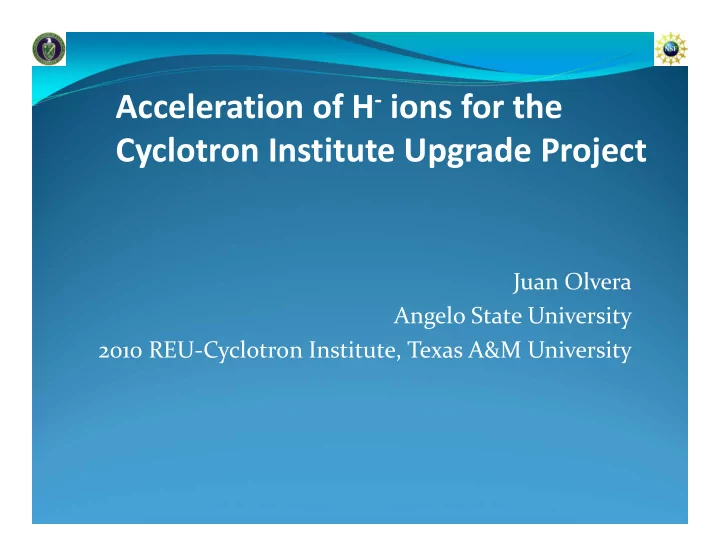

Acceleration of H ‐ ions for the Cyclotron Institute Upgrade Project Juan Olvera Angelo State University 2010 REU ‐ Cyclotron Institute, Texas A&M University
Outline Why we need the K150 Cyclotron Original plans for proton (H + ) beam via ECR2 Problems with proton extraction using ECR2 Enter the H ‐ Source Other upgrades done to K150 Cyclotron Future work Acknowledgments References
Why K150 is Needed • New concept using Rare Isotope Accelerator (RIA) • First proposed experiment: • Requirements for this reaction: • Proton current of 14µA at extraction • Proton current of 10µA on target • Proton beam energy of 30MeV on Al target
Initial Plan for Proton Production Original plan called for use of the Electron Cyclotron Resonance (ECR2) source ECR2 source removes electrons, produces H + Ions (protons) before injection into cyclotron H + are injected into the cyclotron and accelerated
K150 Injection Line 90 deg magnet ECR2
Extraction Problems Activation of deflector Loss of run time Safety hazard – secondary radiation Extraction efficiency of deflector Approximately 50% loss of beam at best
Activation of Deflector Time Time Activity(mCi) Activity(mCi) Dose Rate(mRem/hr) Dose Rate(mRem/hr) 10 min 10 min 1168.108 1168.108 52144.3 52144.3 1 hour 1 hour 1028.649 1028.649 45918.9 45918.9 1 day 1 day 686.216 686.216 30632.7 30632.7 3 days 3 days 390.27 390.27 17421.7 17421.7 5 days 5 days 265.811 265.811 11865.8 11865.8 Na ‐ 22 gamma source Na ‐ 22 gamma source 0.1 0.1 4.5 4.5 Rad worker limit: 5000mRem/year Rad worker limit: 5000mRem/year Distance: .5 meters Distance: .5 meters
Activation of Deflector Sky shine problem
Solutions Build a special deflector for protons Need one for each proton energy, ideally Approximately 80KV bias needed – HV danger HV Sparking – degrades surface, less deflection Build deflector from pure Aluminum Excessive heat – complicates maintenance Make ions via an H ‐ source Best option
Enter the H ‐ Source 100% extraction efficiency from cyclotron No need for deflector ‐ reduces secondary radiation No danger of HV – no sparking, less maintenance Allows production of high intensity proton and deuteron beams
H ‐ Source Placement Source Spool & steering magnet Source
Proton (H + ) Production H ‐ ion collides with Carbon foil 2 microns thick Electrons are stripped away Proton (H + ) emerges from collision
Extraction of Protons
But How to Get H ‐ Ions? Excited Molecules Dissociative Attachment
Source “Tilt” suggested by Olli Tarvainen, JYFL Puller with Einzel H - e - Dump Plasma Lens ions Magnets Electrode e-
Quick Recap Source
Results From First Test 24.5µA at extraction for a brief moment 10µA at extraction, sustained – vacuum problems 60+ hours of filament use without failure
Other Upgrades to the K150 Installed spool, steering magnet, and platform Raised water cooling system – reduced clutter Installed door switches in HV cage – safety precaution Installed safety cage to isolate HV near source Installed gas lines, air lines, electrode covers, helped wire some interlock lines
Future Work Test beam focusing, throughput down the beam line Joe Brinkley will develop program to optimize beam from source Improve ion source – filament is limiting factor Inductively coupled rf ‐ discharge Eliminates filament Inductively heated thermionic emission cathode Extends the lifetime of the filament – further development needed
Acknowledgments National Science Foundation (NSF) Department of Energy (DOE) Texas A&M University The Welch Foundation
Acknowledgments Dr. Henry Clark Dr. Gabriel Tabacaru Joe Brinkley Steve Russell Stephen Molitor Bill Morgan Howard Peeler Leigh Gathings Jason Ford All the shop personnel: Andy, James, Larry, Lee, and Ruben All the nice and helpful people at the Cyclotron Institute
References Clark, Henry. “Project Management Plan for the Cyclotron Institute Upgrade at Texas A&M University” Kalvas, T. and Tarvainen, O. “Extending the Lifetime of Texas A&M H ‐ Ion Source,” University of Jyvaskyla. 13 July 2010. Kalvas, T. et al., “Texas A&M H ‐ Ion Source Extraction Design,” University of Jyvaskyla. 15 May 2009. Kim, G.J., “Status of the K150 Cyclotron Injection LIne,” 25 February 2010. • Tabacaru, G., “Evaluation of the Radiation Shielding System of the 88” Cyclotron Vault at • Texas A&M University.” Zhuravlev, B.V. et al, “Analysis of neutron spectra in interaction of 22 ‐ MeV protons with • nuclei,” Yadernaia Physics. Fig. 39(1984) 264 ‐ 271 “Technical Review V,” January 22 ‐ 23, 2009. •
Questions?
Recommend
More recommend